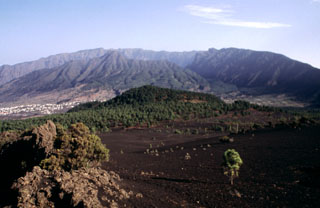Report on La Palma (Spain) — 13 October-19 October 2021
Smithsonian Institution / US Geological Survey
Weekly Volcanic Activity Report, 13 October-19 October 2021
Managing Editor: Sally Sennert.
Please cite this report as:
Global Volcanism Program, 2021. Report on La Palma (Spain) (Sennert, S, ed.). Weekly Volcanic Activity Report, 13 October-19 October 2021. Smithsonian Institution and US Geological Survey.
La Palma
Spain
28.57°N, 17.83°W; summit elev. 2426 m
All times are local (unless otherwise noted)
The eruption at La Palma continued during 13-19 October, characterized by Strombolian explosions, lava fountaining from multiple vents, advancing and branching lava flows, and daily ash emissions. Eruption details are based on official sources, including PEVOLCA (Plan de Emergencias Volcánicas de Canarias) steering committee summaries. Seismicity continued to be elevated, with most earthquakes located 10-15 km deep (though some were deeper than 35 km); dozens of events were felt by local residents, and some were felt across the entire island. The earthquakes were located generally in the same area where the swarm first began on 11 September, though hypocenters slightly shifted S and E. A M 4.5 earthquake was recorded each day during 14-16 October at depths of 36-37 km, though the largest event recorded on 18 October was a M 4.6 that originated at a depth of 36 km.
The vents in the main cone continued to effuse lava and produced ash plumes that rose as high as 5 km (16,400 ft) a.s.l. A vent located 300 m from the SE base of the main cone was again active by 15 October and produced ash-and-gas emissions at least through 19 October; the vent reactivated simultaneously with a period of increased phreatomagmatic activity at the main vent. Sulfur dioxide emissions fluctuated at high levels between 2,882 tons per day and at least 20,000 tons per day. Sulfur dioxide plumes spread out in multiple directions, drifting NW through Spain, France, and Germany on 19 October.
The lava-flow field was characterized by three main areas: the initial main flow that traveled W, flowing around the S part of Montaña de Todoque toward the sea and creating a lava delta; a flow that had branched off of the main flow to the S; and flows that traveled W along the N margins of the main flow. During 13-19 October the lava flows along the northern margins (the N flow) were most active and were comprised of two main branches. On 13 October a preemptive evacuation of about 400 people from La Laguna in Los Llanos de Aridane was initiated as part of the N flow advanced NW. During 15-19 October large blocks were carried downslope by the advancing N flows, and on occasion, the flows would overflow their channels, forming ephemeral flows that spread laterally and descended short distances. The lava flow reached Montaña de La Laguna, traveled around the S part, and continued W toward the sea. By 19 October the end of the flow was 100-110 m from the coastline. The main and S lava flows were being only minimally fed. Small avalanches in areas with thick ash deposits descended slopes near the Tamanca ravine, generating small ash plumes.
By 19 October the flow field was 2.9 km wide and covered almost 7.8 square kilometers. More than 50 kilometers of roads had been damaged. Lava had engulfed 1,956 buildings, 60 of which were partially damaged, and almost 2.3 square kilometers of crops were lost. About 6,400 people had been evacuated. The Alert Level remained at Red (the highest level on a four-color scale) for affected communities.
Geological Summary. The 47-km-long wedge-shaped island of La Palma, the NW-most of the Canary Islands, is composed of two large volcanic centers. The older northern one is cut by the steep-walled Caldera Taburiente, one of several massive collapse scarps produced by edifice failure to the SW. On the south, the younger Cumbre Vieja volcano is one of the most active in the Canaries. The elongated volcano dates back to about 125,000 years ago and is oriented N-S. Eruptions during the past 7,000 years have formed abundant cinder cones and craters along the axis, producing fissure-fed lava flows that descend steeply to the sea. Eruptions recorded since the 15th century have produced mild explosive activity and lava flows that damaged populated areas. The southern tip of the island is mantled by a broad lava field emplaced during the 1677-1678 eruption. Lava flows also reached the sea in 1585, 1646, 1712, 1949, 1971, and 2021.
Sources: Instituto Geográfico Nacional (IGN), Instituto Volcanológico de Canarias (INVOLCAN), Gobierno de Canaries

